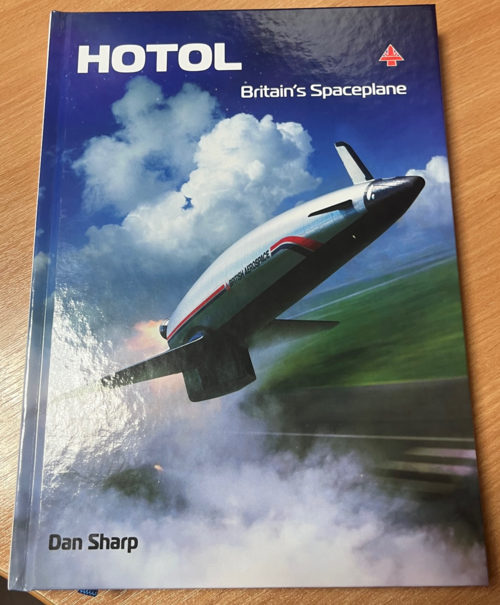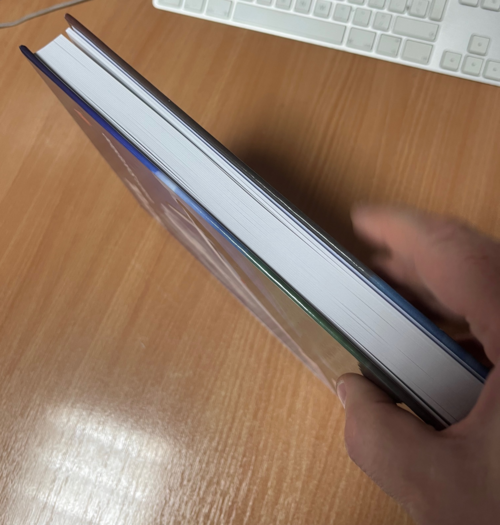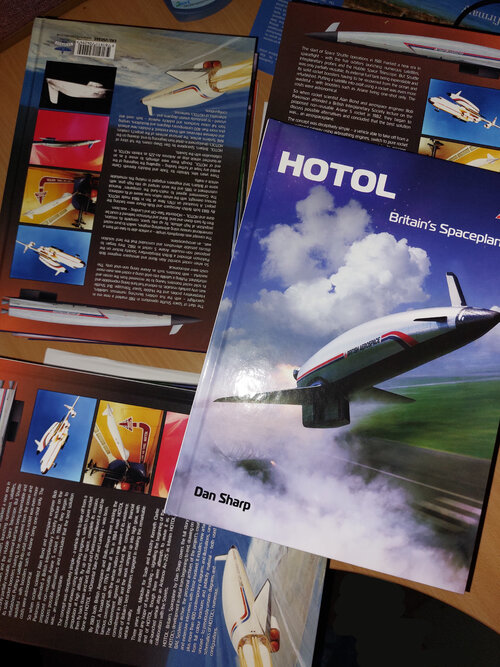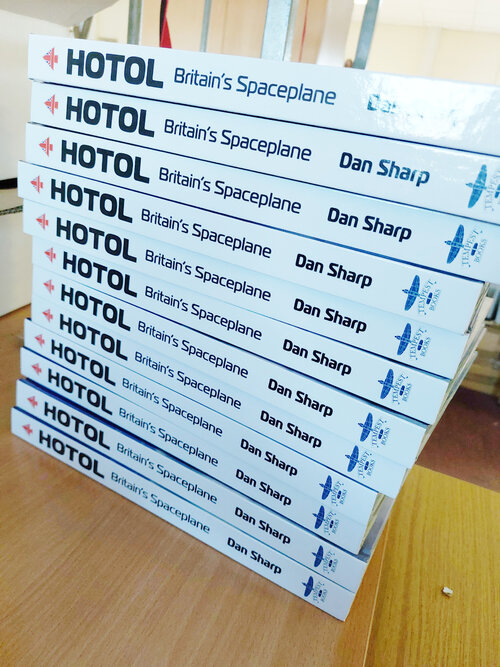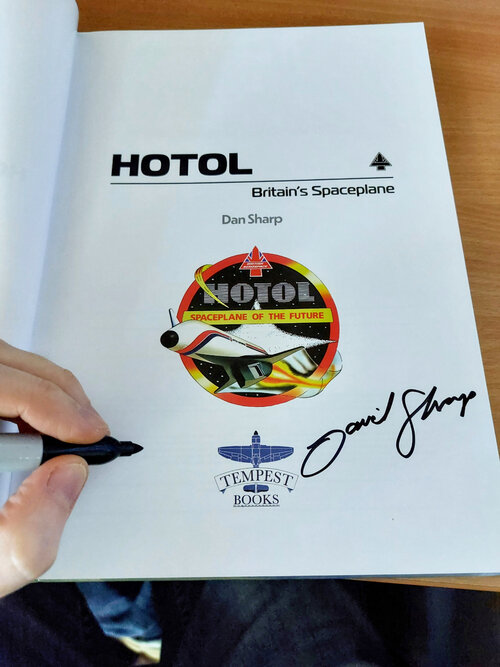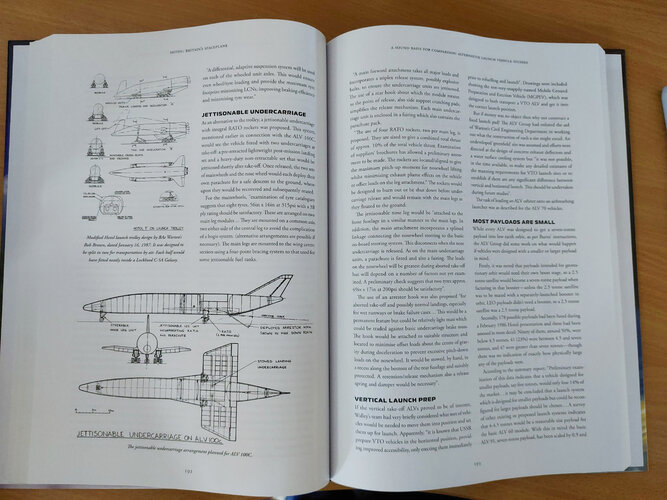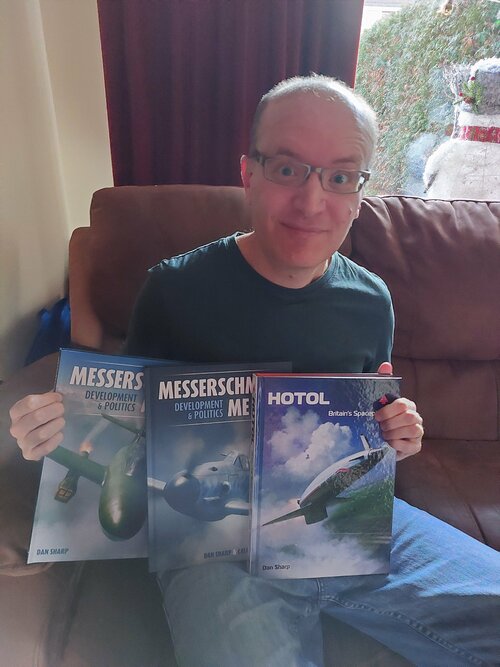My present state of mind : running across the countryside, Chariots of fire style - with that music playing as background.
View: https://www.youtube.com/watch?v=usfiAsWR4qU
You are using an out of date browser. It may not display this or other websites correctly.
You should upgrade or use an alternative browser.
You should upgrade or use an alternative browser.
HOTOL: Britain's Spaceplane by Dan Sharp
- Thread starter newsdeskdan
- Start date
- Joined
- 11 June 2014
- Messages
- 1,541
- Reaction score
- 2,898
Hotol: Britain's Spaceplane has now gone to the page designer. It topped out at 166,752w and 464 images.
Alan Davies
ACCESS: Restricted
- Joined
- 9 October 2019
- Messages
- 11
- Reaction score
- 40
Brilliant news! Really glad you made it.Hotol: Britain's Spaceplane has now gone to the page designer. It topped out at 166,752w and 464 images.
Looking forward to a good read in the New Year
- Joined
- 11 February 2007
- Messages
- 2,543
- Reaction score
- 4,327
For those not up on wordcount, that's about a novel and two thirds!Hotol: Britain's Spaceplane has now gone to the page designer. It topped out at 166,752w and 464 images.
FighterJock
ACCESS: Above Top Secret
- Joined
- 29 October 2007
- Messages
- 5,594
- Reaction score
- 5,914
Excellent news Dan, cannot wait to get my hands on it. Though I would think that it is going to be a long wait.
Rhinocrates
ACCESS: Top Secret
- Joined
- 26 September 2006
- Messages
- 3,044
- Reaction score
- 7,718
Whatever day it arrives will be Christmas for me. It'll be a little poignant now that Reaction Engines has gone into administration.
martinbayer
ACCESS: Top Secret
- Joined
- 6 January 2009
- Messages
- 3,378
- Reaction score
- 3,859
Ordered the book today in person at a local SoCal B&N. Should have it in my grubby little (well, sorta biggish, really) hands by Xmas time. Looking forward to any mention of LART... 
Last edited:
- Joined
- 11 June 2014
- Messages
- 1,541
- Reaction score
- 2,898
Ordered the book today in person at a local SoCal B&N. Should have it in my grubby little (well, sorta biggish, really) hands by Xmas time. Looking forward to any mention of LART...
It's in there - don't worry!
Owens Z
quaerimus scientiam
- Joined
- 6 October 2023
- Messages
- 221
- Reaction score
- 286
Mr Sharp, I gave your forthcoming book a recent mention in the thread "Reaction Engines SABRE engine (Skylon Spaceplane)", where discussion proceeds on the sad death of the UK company Reaction Engines, designer of the Skylon spaceplane, and founded as you know by some of the engineers who had worked on the earlier HOTOL. Assuming your forthcoming HOTOL book is as bestselling as it deserves (and I will do my part by buying a copy), would you perhaps be interested in someday writing a similar book on Skylon? (A technical history of the spaceplane, not a boring political/bureaucratic history of the company.)
- Joined
- 6 November 2010
- Messages
- 5,258
- Reaction score
- 5,499
I would not mind a bit if that were part of the book.political/bureaucratic history of the company
- Joined
- 11 June 2014
- Messages
- 1,541
- Reaction score
- 2,898
The technical history of Skylon is outlined in this book. I quizzed Mark Hempsell on some aspects of its design and he was very helpful in giving me a clearer picture of how it developed.
Owens Z
quaerimus scientiam
- Joined
- 6 October 2023
- Messages
- 221
- Reaction score
- 286
The technical history of Skylon is outlined in this book. I quizzed Mark Hempsell on some aspects of its design and he was very helpful in giving me a clearer picture of how it developed.
Excellent. I look forward to your new book now more than ever. I see that Amazon estimates it will be available in the USA around mid-February 2025, if that sounds about right.
I wrote recently in the thread "Reaction Engines SABRE engine (Skylon Spaceplane)" that the Skylon design had addressed many of the problems HOTOL had by moving the engines from the stern to the wingtips. But red admiral points out there in response to SteveO (posts #663-4) that the wingtip position might have caused hot plumes to scrub the rear of Skylon at high altitudes, resulting in "issues for the aft fuselage structure and thin, brittle TPS covering it", which seems insightful. Ah me: there's always something! Spaceplane design is difficult...
- Joined
- 11 June 2014
- Messages
- 1,541
- Reaction score
- 2,898
Excellent. I look forward to your new book now more than ever. I see that Amazon estimates it will be available in the USA around mid-February 2025, if that sounds about right.
I wrote recently in the thread "Reaction Engines SABRE engine (Skylon Spaceplane)" that the Skylon design had addressed many of the problems HOTOL had by moving the engines from the stern to the wingtips. But red admiral points out there in response to SteveO (posts #663-4) that the wingtip position might have caused hot plumes to scrub the rear of Skylon at high altitudes, resulting in "issues for the aft fuselage structure and thin, brittle TPS covering it", which seems insightful. Ah me: there's always something! Spaceplane design is difficult...
The most innovative aspect of Skylon, some might say, was the undercarriage. One of Hotol's great drawbacks was its trolley - whereas Skylon was intended to use relatively conventional retractable gear during take-off (very high pressure tyres, very hard runway surface, very long runway).
In terms of the wingtip engine positions, others have pointed out that getting the required pipework (big, thick pipes needed to transfer the required volumes of cryogenic liquid - known as 'the spaghetti' on Hotol) into the wings would have been a big ask.
Alan Bond did concede to me, when I asked him about them, that the wingtip engines were not ideal. I asked him what he thought the best alternative configuration might be and he asked if I'd ever heard of the North American Navaho missile - with its engines faired into the sides of the fuselage.
Damn interesting. But intakes placed there may swallow truckloads of reentry plasma, and the engines wouldn't like it. Black Colt / Rocketplane Pathfinder had similar issues with its plain old turbofans : they moved a lot across successive iterations - and eventually ended at the same place as Buran's AL-31F (see the wonderful thread we have). Same place as the Shuttle OMS pods: flanking the vertical tail, with the rocketplane main body moving the plasma away.
Attachments
- Joined
- 11 June 2014
- Messages
- 1,541
- Reaction score
- 2,898
Damn interesting. But intakes placed there may swallow truckloads of reentry plasma, and the engines wouldn't like it. Black Colt / Rocketplane Pathfinder had similar issues with its plain old turbofans : they moved a lot across successive iterations - and eventually ended at the same place as Buran's AL-31F (see the wonderful thread we have). Same place as the Shuttle OMS pods: flanking the vertical tail, with the rocketplane main body moving the plasma away.
Like Hotol, Skylon's intakes closed for re-entry. With Hotol, there were 'doors' which closed, blanking them off. For Skylon, the centrebodies moved forwards until the intake was sealed. Following re-entry, the vehicle made an unpowered descent to the runway.
Last edited:
martinbayer
ACCESS: Top Secret
- Joined
- 6 January 2009
- Messages
- 3,378
- Reaction score
- 3,859
During the very early days of the concept I faintly remember seeing a small sketch of HOTOL (perhaps in Flight International?) that did indeed appear to have been heavily inspired by the Navaho design.The most innovative aspect of Skylon, some might say, was the undercarriage. One of Hotol's great drawbacks was its trolley - whereas Skylon was intended to use relatively conventional retractable gear during take-off (very high pressure tyres, very hard runway surface, very long runway).
In terms of the wingtip engine positions, others have pointed out that getting the required pipework (big, thick pipes needed to transfer the required volumes of cryogenic liquid - known as 'the spaghetti' on Hotol) into the wings would have been a big ask.
Alan Bond did concede to me, when I asked him about them, that the wingtip engines were not ideal. I asked him what he thought the best alternative configuration might be and he asked if I'd ever heard of the North American Navaho missile - with its engines faired into the sides of the fuselage.
Owens Z
quaerimus scientiam
- Joined
- 6 October 2023
- Messages
- 221
- Reaction score
- 286
The most innovative aspect of Skylon, some might say, was the undercarriage. One of Hotol's great drawbacks was its trolley - whereas Skylon was intended to use relatively conventional retractable gear during take-off (very high pressure tyres, very hard runway surface, very long runway).
I do remember HOTOL's trolley, and the plan to use more conventional takeoff gear for the now-defunct Skylon. In addition to your three very's, I recall from reading about this in the 1990's that the plan (perhaps later revised) was to make do with small and thus light brakes on the wheels, suitable for stopping an almost-empty vehicle. In case of a rejected takeoff at maximum weight, a considerable amount of cooling water would be carried aboard Skylon and sprayed over the brakes to keep them from melting. A normal takeoff would mean jettisoning this water immediately after wheels up.
I put in a plea earlier (#100) for some informative and human-crafted line drawings inside the book, which you seemed amenable to, and now with coverage of Skylon to be included, "I'm in fat city", as my father would say. When your book is published, I look forward to buying a copy and putting some royalties into your hands.
I suppose that (by definition) you cannot comment on the selected deletions. But can you assure your readers now that after whatever the censors had removed was removed, your forthcoming book remains a comprehensive, truthful, warts-and-all account of these fascinating spaceplane designs?
- Joined
- 11 June 2014
- Messages
- 1,541
- Reaction score
- 2,898
I do remember HOTOL's trolley, and the plan to use more conventional takeoff gear for the now-defunct Skylon. In addition to your three very's, I recall from reading about this in the 1990's that the plan (perhaps later revised) was to make do with small and thus light brakes on the wheels, suitable for stopping an almost-empty vehicle. In case of a rejected takeoff at maximum weight, a considerable amount of cooling water would be carried aboard Skylon and sprayed over the brakes to keep them from melting. A normal takeoff would mean jettisoning this water immediately after wheels up.
I put in a plea earlier (#100) for some informative and human-crafted line drawings inside the book, which you seemed amenable to, and now with coverage of Skylon to be included, "I'm in fat city", as my father would say. When your book is published, I look forward to buying a copy and putting some royalties into your hands.
I suppose that (by definition) you cannot comment on the selected deletions. But can you assure your readers now that after whatever the censors had removed was removed, your forthcoming book remains a comprehensive, truthful, warts-and-all account of these fascinating spaceplane designs?
Yes you're right about the brakes/water cooling on Skylon.
The Hotol book is indeed a comprehensive, truthful and warts-and-all account. It's based on period documents and the manuscript has been read by (in addition to BAE Systems' legal people):
BAe Warton Hotol deputy project manager and propulsion lead Gerald Wilson
BAe Warton Hotol performance lead Steve Furniss
BAe Warton Hotol aerodynamics lead Alison Wake
BAe Warton Advanced Projects Dept CAPS architect Eric Webb
BAe Stevenage Hotol originator and space operation lead Dr Bob Parkinson
BAe Stevenage engineer and later Reaction Engines director Mark Hempsell
Hotol co-originator and Reaction Engines founder Alan Bond told me he didn't need to read it prior to publication, unless I insisted that he do so - and I didn't feel I could really insist!
All (except Alan, obviously) gave comments and added recollections, which were worked into the text in one form or another. None asked me to delete anything I'd written - just to add to what was already there with further detail.
I was surprised by the minimal number of changes BAE Systems asked for. At one point I seriously feared for the book's future, given the noises I was getting during the vetting process. But in the end the small number of deletions made very little difference to the 'comprehensive, truthful, warts-and-all' nature of the book. The biggest thing was the requirement that I delete the list of documents I consulted (and it was a long list) - effectively the bibliography. I can sort of see why they wouldn't want some of that information made publicly available.
martinbayer
ACCESS: Top Secret
- Joined
- 6 January 2009
- Messages
- 3,378
- Reaction score
- 3,859
Godspeed, Dan!
FighterJock
ACCESS: Above Top Secret
- Joined
- 29 October 2007
- Messages
- 5,594
- Reaction score
- 5,914
Getting rather excited now.
- Joined
- 11 June 2014
- Messages
- 1,541
- Reaction score
- 2,898
The first full-book proof has now been delivered by the page designer. It comes out at 414 pages, but that's without the index so it's likely to be around 420 pages.
As I said on November 3, it's 166,752 words (slightly more now, in fact) and 464 images. As such, it wll be the biggest and longest book I've ever produced.
Here are a few lo-res sample pages.



As I said on November 3, it's 166,752 words (slightly more now, in fact) and 464 images. As such, it wll be the biggest and longest book I've ever produced.
Here are a few lo-res sample pages.
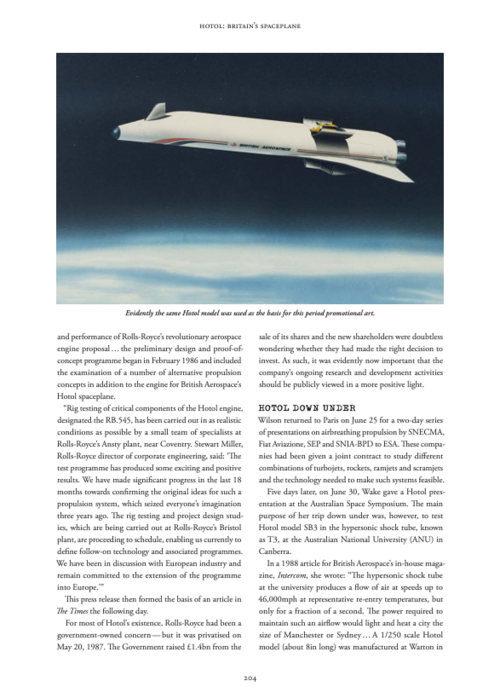
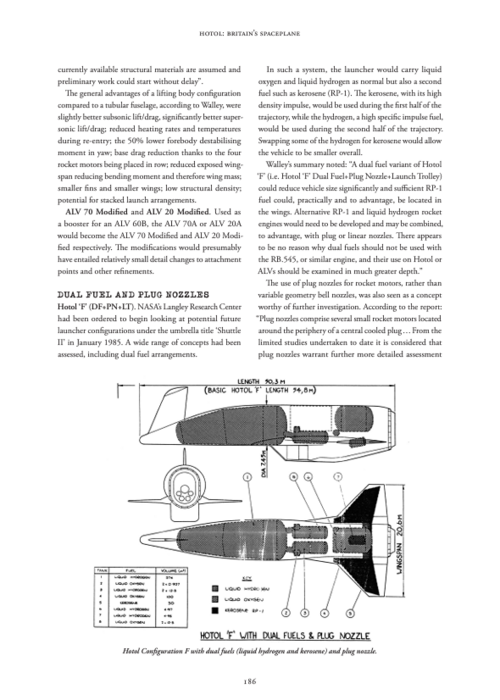
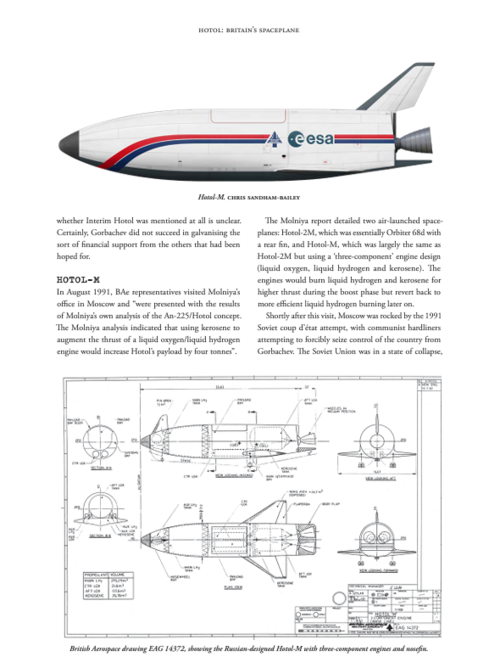
Last edited:
martinbayer
ACCESS: Top Secret
- Joined
- 6 January 2009
- Messages
- 3,378
- Reaction score
- 3,859
Outstanding - sounds like a truly seminal work on the history of HOTOL!
- Joined
- 11 June 2014
- Messages
- 1,541
- Reaction score
- 2,898
Outstanding - sounds like a truly seminal work on the history of HOTOL!
It doesn't really have any competition, to be fair. It is the first and only book written solely about HOTOL.
- Joined
- 11 June 2014
- Messages
- 1,541
- Reaction score
- 2,898
Finished writing the index at 5.30pm today. The printer is lined up and waiting for the pdfs. Aiming to send it off tomorrow morning (November 27). On that basis, it's still just possible that physical copies might reach some customers before Christmas.
- Joined
- 11 June 2014
- Messages
- 1,541
- Reaction score
- 2,898
HOTOL: Britain's Spaceplane has now been signed off at the printers and it's just a case of how quickly they can print it and get it back to the publisher for distribution. Current estimate is mid-late December.
FighterJock
ACCESS: Above Top Secret
- Joined
- 29 October 2007
- Messages
- 5,594
- Reaction score
- 5,914
Oh dear so not available for the Christmas rush then dan? That is a pity, though something to look forward to post new year then.
- Joined
- 11 June 2014
- Messages
- 1,541
- Reaction score
- 2,898
Oh dear so not available for the Christmas rush then dan? That is a pity, though something to look forward to post new year then.
The book was written in good time for Christmas (completed by early September) but unfortunately further production was delayed then by two months due to vetting. Without that, the book would've been completed at the end of September and would've been available mid-late October.
Last edited:
Where's best option to order from ? directly via publisher at Tempest or ?
Best Wishes for the new book
Best Wishes for the new book
Last edited:
- Joined
- 11 June 2014
- Messages
- 1,541
- Reaction score
- 2,898
FighterJock
ACCESS: Above Top Secret
- Joined
- 29 October 2007
- Messages
- 5,594
- Reaction score
- 5,914
Looking good Dan, I cannot wait to get my hands on one now.
- Joined
- 11 June 2014
- Messages
- 1,541
- Reaction score
- 2,898
Apparently the full production run of copies is due to arrive at the publisher's premises on Wednesday, December 18. That's just prior to the last post for parcels within the UK. So it seems like people in the UK who've ordered a copy might still be in with a chance of getting it before Christmas.
Owens Z
quaerimus scientiam
- Joined
- 6 October 2023
- Messages
- 221
- Reaction score
- 286
Damn interesting. But intakes placed there may swallow truckloads of reentry plasma, and the engines wouldn't like it. Black Colt / Rocketplane Pathfinder had similar issues with its plain old turbofans : they moved a lot across successive iterations - and eventually ended at the same place as Buran's AL-31F (see the wonderful thread we have). Same place as the Shuttle OMS pods: flanking the vertical tail, with the rocketplane main body moving the plasma away.
The Shuttle Orbiter flew fine (with, of course, no air intakes needed for its AJ10-190 OMS rocket motors), and I heard that the jet-powered Buran testbed was quite sprightly (although that never flew fast enough to worry about plasma). I defer to what is Dan Sharp's presumably definitive forthcoming book, but I recall from the time (late 1980s) that the mass of engines astern, your recommended position Archibald, just could not be made to work balance-wise no matter what tweaks were made to the HOTOL design. Thus Skylon's later move of the engines to the wingtips. Air intakes could be closed off when air-breathing is unneeded, to avoid the ingestion problems you worry about. A future spaceplane with an SM-64 Navaho-type layout, with most of the engine mass amidships (for balance) but the nozzles far astern (to avoid scrubbing by the hot exhaust) might indeed be better, as Mr Sharp mentions that Alan Bond had mused.
Owens Z
quaerimus scientiam
- Joined
- 6 October 2023
- Messages
- 221
- Reaction score
- 286
Apparently the full production run of copies is due to arrive at the publisher's premises on Wednesday, December 18. That's just prior to the last post for parcels within the UK. So it seems like people in the UK who've ordered a copy might still be in with a chance of getting it before Christmas.
I hope that UK customers get their copies of HOTOL: Britain's Spaceplane just in time for Christmas; good luck. For Americans like me interested in Mr Sharp's new book, Barnes & Noble and Amazon estimate availability in mid-February 2025.
FighterJock
ACCESS: Above Top Secret
- Joined
- 29 October 2007
- Messages
- 5,594
- Reaction score
- 5,914
Same for me Archibald, Waterstones UK has it down for 6th January.
- Joined
- 19 July 2016
- Messages
- 4,270
- Reaction score
- 3,450
Likewise 6th Jan but, still a happy kid eyeing the shelves and looking for space. I feel another amateur shelf addition in production sometime soon.
- Joined
- 11 June 2014
- Messages
- 1,541
- Reaction score
- 2,898
- Joined
- 11 June 2014
- Messages
- 1,541
- Reaction score
- 2,898
Similar threads
-
Secret Projects: Military Space Technology by Bill Rose
- Started by overscan (PaulMM)
- Replies: 35
-
Air Launch Spaceplanes: any published supersonic separation analysis?
- Started by FutureSpaceTourist
- Replies: 3
-
Microwave Power Beaming May Launch Space Planes into Orbit
- Started by bobbymike
- Replies: 3
-
-

